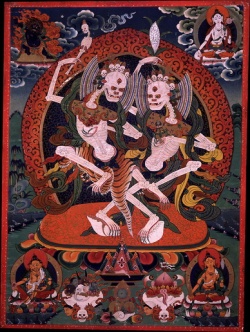Avidya
Avidyā (Sanskrit; Pāli: avijjā; Tibetan phonetic: ma rigpa) is commonly translated as "ignorance" or "delusion". avidya: Literally, 'Without illumination' or 'unseeing'. Ignorance is a crude translation of this term which is so fundamental to the Buddhist perspective. Avidya is held to be the root cause of one's coming to exist in this plane of affliction, continuing to crave and cling to it, and repeatedly returning without understanding. Hence, 'ignorance' here is the subtle ignorance of the fundamental reality of phenomenal existence.
See also; "vidya."
It can be defined as not understanding the full meaning and implication of the Four Noble Truths or as a fundamental misunderstanding of the nature of reality. Avidyā is identified within the Buddhist teachings as follows:
- The first link in the twelve links of Dependent origination.
- One of the Three poisons within the Mahayana Buddhist tradition.
- One of the six root Kleshas within the Mahayana Abhidharma teachings
- One of the ten Fetters in the Theravada tradition
- Equivalent to Moha within the Theravada Abhidharma teachings
Within the context of the twelve links of Dependent origination, avidya is typically symbolized by a person who is blind or wearing a blindfold.
Overview
Avidya is explained in different ways or on different levels within different Buddhist teachings or traditions. On the most fundamental level, it is a misunderstanding of the nature of reality; more specifically–a misunderstanding or mis-perception of the nature of self and of phenomena. On a more general level, avidya can be defined as not understanding the full meaning and implication of the Four Noble Truths.
Ron Leifer explains:
- From the Buddhist point of view, the unwillingness or failure to see the facts of life as they are, to see ourselves as we are, and to conduct ourselves in harmony with these realities, is the chief cause of our self-inflicted Suffering and, therefore the chief obstacle to our happiness. This state of denial, or lack of realization of the facts of existence, is called avidya in Sanskrit--literally, "the failure to see or know"--translated as "ignorance". One of the great contributions of Gautama Buddha was the realization that ignorance is the primary cause of the sufferings we impose on ourselves and others.
Ringu Tulku explains the nature of avidya (ignorance) as follows:
- In the Buddhist sense, ignorance is equivalent to the identification of a self as being separate from everything else. It consists of the belief that there is an "I" that is not part of anything else. On this basis we think, "I am one and unique. Everything else is not me. It is something different."... From this identification stems the dualistic view, since once there is an "I," there are also "others." Up to here is "me." The rest is "they." As soon as this split is made, it creates two opposite ways of reaction: "This is nice, I want it!" and "This is not nice, I do not want it!" ...
Traditional definitions
Theravada
Bhikkhu Bodhi provides the following definition based on the Theravada Abhidharma teachings:
- Ignorance (Avijja) is the Cetasika delusion (Moha), which obscures perception of the true nature of things just as a cataract obscures perception of visible objects. According to the Suttanta method of explanation, ignorance is non-knowledge of the Four Noble Truths. According to the Abhidharma method, ignorance is non-knowledge of eight things: the Four Noble Truths, the pre-natal past, the post-mortem future, the past and the future together, and Dependent arising.
Bhikkhu Bodhi explains the relationship between the terms Avijja and Moha as follows:
- Ignorance (Avijja) is actually identical in nature with the unwholesome root "delusion" (Moha). When the Buddha speaks in a psychological context about Mental factors, he generally uses the word "delusion" (Moha); when he speaks about the causal basis of Samsara, he uses the word "ignorance" (Avijja).
Nina van Gorkom states:
- Moha is ignorant of the true nature of realities, it does not know nāma and Rūpa as they are. Moha is lack of knowledge about the Four Noble Truths: about Dukkha, the origination of Dukkha, the ceasing of Dukkha and the way leading to the ceasing of Dukkha. So long as ignorance has not been eradicated we have to continue to be in the cycle of birth and death, we have to be born again and again. The Pāli term avijjā is used for ignorance in connection with the “Dependent origination”, the conditional arising of phenomena in the cycle of birth and death. Avijjā is the first link in the chain of conditions for the continuation of this cycle. At the attainment of arahatship ignorance is eradicated and then there are no more conditions for Rebirth.
Mahayana
Mipham Rinpoche provides the following definition based on the Mahayana Abhidharma:
- Ignorance means not knowing the [law of] actions and their effects, the four truths, and the virtues of the Precious Ones. It cases all affliction to occur.
The Abhidharma-samuccaya states:
- What is ignorance (avidya)? It is a lack of being aware to one's fullest capacity and it covers the three realms of life. Its function is to serve as it basis for mistaken stubbornness, doubt and emotionality about the entities of reality.
In the Mahayana tradition, two levels of ignorance (avidya) are identified. Dzigar Kongtrul explains:
- There are two levels of ignorance: ignorance of the absolute, or the essential nature of phenomena, and the ignorance that prevents us from taking an accurate reading of the relative world. These two kinds of ignorance are like two kinds of thread: When they are tightly woven together, they are not easy to identify, yet they make up the fabric of delusion.
- As a result of the first type of ignorance, we lack Wisdom. Lacking an understanding of our true nature, we perceive that which is illusory and spacious to be solid and real. The second type of ignorance is the inability to clearly understand the laws of Karma and interdependence, which then results in an inaccurate relationship to the world.
Within the twelve nidanas
Avidya is identified as the first of the twelve links of Dependent origination (twelve nidanas)—a sequence of links that describe a karmic process that keeps being bound within Samsara (cyclic existence).
Ajahn Sucitto explains:
- The sequence of Dependent origination begins with the condition of unknowing or ignorance (avijjā), which in Buddhist iconography is depicted as either a blind man or someone wearing a blindfold. This is the driver of the bus to Dukkha [i.e. suffering. If you have to choose the one determining factor for Suffering, it’s this ignorance. People tend to take “ignorance” as pejorative, but it more precisely refers to a lack of gnosis or insightful seeing. It is summarized as “not understanding the Four Noble Truths”—or, perhaps more accurately, not understanding their implications. That is, as long as there is the condition of ignorance, the mind still expects to find an experience that is completely satisfying and feels disappointed when things “go wrong.” There is a parable of a man eating a bag of chili peppers one by one, weeping at their fiery taste as he does so. When asked why he continues to eat the peppers, he replies, “I’m looking for the sweet one.” This is ignorance.
Chogyam Trungpa states:
- The twelve nidanas begins with what's called ignorance. It is ignorant in the sense that our own struggle has not been seen. We are unable to see our own struggle properly and completely, therefore there is this notion of blindness. The imagery for this is what's called the blind mother principle. A blind grandmother has no chance to see her grandchildren. She has her own concepts and ideas about how the world should function in her particular period of time in history and her particular social setup. All of that is on one level, that of blindness. And within the blindness, the grandmother struggles enormously, trying to communicate with her grandchildren constantly. The blind grandmother is also highly inquisitive and extremely interested in any kind of gossip that involves the grandchildren. Her way of maintaining Power over her grandchildren is to maintain her intelligence of the gossip, which is what is called subconscious gossip: who got married, who had children, who got divorced, who got killed, who had cancer, who had an accident--that and this, this and that, this, this, that... That kind of gossip is endless...it goes on like a wheel which revolves again and again and again, maintaining constant eternity. Therefore, the second Nidana process, which is called samskara...is traditionally analogized by a potter's wheel...This represents conceptual mind forming itself in a certain situation, and this is the point at which the creation of Karma begins.
Uprooting avidya
The antidote to avidyā is the development of correct knowledge and perception: "Wisdom" (Skt.: prajñā; Pali: Pañña). This can be achieved by training in ethics, concentration, and logical analysis of reality. More generally, Wisdom is developed by following The Eightfold Path.
In a bit more elaborate way, ignorance is the antithesis of correct knowledge and correct perception. The ontological, epistemological, and metaphysical differences between Buddhist schools of practice and philosophy are hotly debated by scholars, both Buddhist and Western; however, philosophically and practically one can assert that all the schools use both concentration (Samatha) and analysis (Vipassana) to negate impossible modes of existence which appear to our ordinary, naive mind during the course of ordinary activity.
In the case of the Theravada, in general, one is analytically negating a permanent, unchanging self or phenomenon using logical analysis and single-pointed concentration. In the cause of the Mahayana, in general, one is analytically negating an inherent, truly existent, or dual self of persons and phenomenon using analysis and single-pointed concentration (see Diamond Slivers and Concentration Training). The object being negated in both cases is a unitary, unchanging, eternal, self-sustaining, self-arising phenomenon which appears (to our naive ordinary day-to-day mind) to provide identity to the experiencer or to the objects of experience. In other words, there appears to be a real "I, me" which sits behind our mind and body somewhere which is having our experiences and is the real "I, me" which makes decisions for the body and mind.
There also appears to be objects and people outside of ourselves who project identities and qualities that we just happen to be there to experience: there seems to be a "real table quality out there" which makes the table what it is. Commonly people would say, "It is what it is." Meaning, that there is something in the object or about the object which makes it what it is, and that the observer (you, me, cat, dog, cockroach, etc.) has nothing to do with that. That type of inherent, unchanging identity is termed Avidya. The misperception of an inherent or unchanging phenomenon and an inherent or unchanging "I, me" allows the mind to generate all sorts of negative emotions (see Kleshas).
In terms of correct analysis to overcome this mistaken perception, the actual experience which is perceived by all Buddhist is identical: a mere absence or negation of the impossible modes of existence which appear to the conventional, naive mind. However, after the inferential or direct experience of that, when the practitioner returns to a non-concentrated, non-analytic state they are once again privy to philosophical training received prior to that experience. Therefore, one practitioner will describe that experience as being a mere lack of inherent existence, another will say it is a mere lack of true existence, another will say it is an inseparability of mind and reality, and another will say it is a mere lack of permanence/stasis. In terms of correct philosophical language, only one school can be correct, but in terms of direct valid experience all schools may or may not be correct. This is a debate point among the different schools and sub-schools.
Etymology
The term vidya means "to see" or "to know". The term a is a negation. Therefore, avidya means to "not see" or "not know".
The word is derived from the Proto-Indo-European root *weid-, meaning "to see" or "to know". It is a cognate with the Latin verb vidēre' (to see)' and English "wit".
Roshi Enkyo O’Hara states that the Chinese and Japanese symbols for this term show the character “mu”, a barrier, next to the characters for the sun and moon: meaning no sun and moon, no light, no clarity, no knowing–a completely deluded state.



